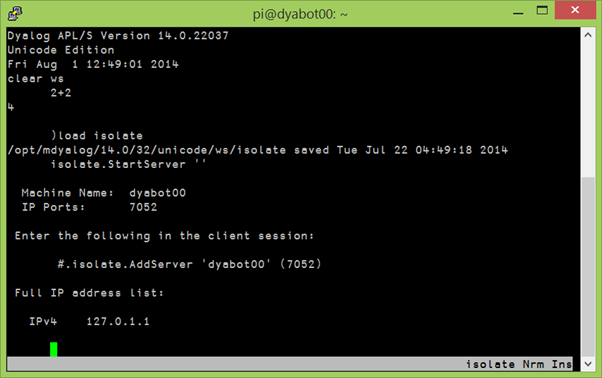(⎕io←0 and timings are done in Dyalog version 15.0.)
Table Look-Up
Some functions can be computed faster by table look-up than a more traditional and more conventional calculation. For example:
b←?1e6⍴2
cmpx '*b' '(*0 1)[b]'
*b → 1.32E¯2 | 0% ⎕⎕⎕⎕⎕⎕⎕⎕⎕⎕⎕⎕⎕⎕⎕⎕⎕⎕⎕⎕⎕⎕⎕⎕⎕⎕⎕⎕⎕⎕
(*0 1)[b] → 1.23E¯3 | -91% ⎕⎕⎕Some observations about this benchmark:
(a) The advantage of table look-up depends on the time to calculate the function directly, versus the time to do indexing, ⍺[⍵] or ⍵⌷⍺, plus a small amount of time to calculate the function on a (much) smaller representative set.
Indexing is particularly efficient when the indices are boolean:
bb←b,1
bi←b,2
cmpx '2 3[bb]' '2 3 3[bi]'
2 3[bb] → 1.12E¯4 | 0% ⎕⎕⎕⎕⎕
2 3 3[bi] → 7.39E¯4 | +558% ⎕⎕⎕⎕⎕⎕⎕⎕⎕⎕⎕⎕⎕⎕⎕⎕⎕⎕⎕⎕⎕⎕⎕⎕⎕⎕⎕⎕⎕⎕bi is the same as bb except that the last element of 2 forces it to be 1-byte integers (for bi) instead of 1-bit booleans (for bb).
(b) Although the faster expression works best with 0-origin, the timing for 1-origin is similar.
cmpx '*b' '{⎕io←0 ⋄ (*0 1)[⍵]}b'
*b → 1.32E¯2 | 0% ⎕⎕⎕⎕⎕⎕⎕⎕⎕⎕⎕⎕⎕⎕⎕⎕⎕⎕⎕⎕⎕⎕⎕⎕⎕⎕⎕⎕⎕⎕
{⎕io←0 ⋄ (*0 1)[⍵]}b → 1.22E¯3 | -91% ⎕⎕⎕That is, if the current value of ⎕io is 1, the implementation can use a local ⎕io setting of 0.
(c) The fact that *b is currently slower than (*0 1)[b] represents a judgment by the implementers that *b is not a sufficiently common computation to warrant writing faster code for it. Other similar functions already embody the table look-up technique:
cmpx '⍕b' '¯1↓,(2 2⍴''0 1 '')[b;]'
⍕b → 6.95E¯4 | 0% ⎕⎕⎕⎕⎕⎕⎕⎕⎕⎕⎕⎕⎕⎕⎕⎕⎕⎕⎕⎕⎕⎕⎕⎕⎕⎕⎕⎕⎕⎕
¯1↓,(2 2⍴'0 1 ')[b;] → 6.92E¯4 | -1% ⎕⎕⎕⎕⎕⎕⎕⎕⎕⎕⎕⎕⎕⎕⎕⎕⎕⎕⎕⎕⎕⎕⎕⎕⎕⎕⎕⎕⎕⎕Small Domains
Table look-up works best for booleans, but it also works for other small domains such as 1-byte integers:
i1←?1e6⍴128 ⍝ 1-byte integers
cmpx '*i1' '(*⍳128)[i1]'
*i1 → 1.48E¯2 | 0% ⎕⎕⎕⎕⎕⎕⎕⎕⎕⎕⎕⎕⎕⎕⎕⎕⎕⎕⎕⎕⎕⎕⎕⎕⎕⎕⎕⎕⎕⎕
(*⍳128)[i1] → 9.30E¯4 | -94% ⎕⎕
cmpx '○i1' '(○⍳128)[i1]'
○i1 → 2.78E¯3 | 0% ⎕⎕⎕⎕⎕⎕⎕⎕⎕⎕⎕⎕⎕⎕⎕⎕⎕⎕⎕⎕⎕⎕⎕⎕⎕⎕⎕⎕⎕⎕
(○⍳128)[i1] → 9.25E¯4 | -67% ⎕⎕⎕⎕⎕⎕⎕⎕⎕⎕In general, a table for 1-byte integers needs to have values for ¯128+⍳256. Here ⍳128 is used to simulate that in C indexing can be done on 1-byte indices without extra computation on the indices. In APL, general 1-byte indices are used as table[i1+128]; in C, the expression is (table+offset)[i].
Domains considered “small” get bigger all the time as machines come equipped with ever larger memories.
Larger Domains
Table look-up is applicable when the argument is not a substantial subset of a large domain and there is a fast way to detect that it is not.
i4s←1e7+?1e6⍴1e5 ⍝ small-range 4-byte integers
G←{(⊂u⍳⍵)⌷⍺⍺ u←∪⍵}
cmpx '⍟i4s' '⍟G i4s'
⍟i4s → 1.44E¯2 | 0% ⎕⎕⎕⎕⎕⎕⎕⎕⎕⎕⎕⎕⎕⎕⎕⎕⎕⎕⎕⎕⎕⎕⎕⎕⎕⎕⎕⎕⎕⎕
⍟G i4s → 9.59E¯3 | -34% ⎕⎕⎕⎕⎕⎕⎕⎕⎕⎕⎕⎕⎕⎕⎕⎕⎕⎕⎕⎕The definition of G implements that the argument is not used directly as indices (as in (⊂⍵)⌷⍺⍺ u) but needed to be looked up, the u⍳⍵ in (⊂u⍳⍵)⌷⍺⍺ u. Thus both index-of and indexing are key enablers for making table look-up competitive.
§4.3 of Notation as a Tool of Thought presents a different way to distribute the results of a calculation on the “nub” (unique items). But it takes more time and space and is limited to numeric scalar results.
H←{(⍺⍺ u)+.×(u←∪⍵)∘.=⍵}
i4a←1e7+?1e4⍴1e3 ⍝ small-range 4-byte integers
cmpx '⍟i4a' '⍟G i4a' '⍟H i4a'
⍟i4a → 1.56E¯4 | 0%
⍟G i4a → 6.25E¯5 | -60%
⍟H i4a → 1.78E¯1 | +113500% ⎕⎕⎕⎕⎕⎕⎕⎕⎕⎕⎕⎕⎕⎕⎕⎕⎕⎕⎕⎕⎕⎕⎕⎕⎕⎕⎕⎕⎕⎕The benchmark is done on the smaller i4a as a benchmark on i4s founders on the ≢∪⍵ by ≢⍵ boolean matrix (for i4s, 12.5 GB = ×/ 0.125 1e5 1e6) created by H.
Mathematical Background
“New Math” teaches that a function is a set of ordered pairs whose first items are unique:
*⍵: {(⍵,*⍵)|⍵∊C} The set of all (⍵,*⍵) where ⍵ is a complex number
⍟⍵: {(⍵,⍟⍵)|⍵∊C~{0}} The set of all (⍵,⍟⍵) where ⍵ is a non-zero complex number
○⍵: {(⍵,○⍵)|⍵∊C} The set of all (⍵,○⍵) where ⍵ is a complex number
⍕⍵: {(⍵,⍕⍵)|0=⍴⍴⍵} The set of all (⍵,⍕⍵) where ⍵ is a scalarWhen ⍵ is restricted (for example) to the boolean domain, the functions, the sets of ordered pairs, are more simply represented by enumerating all the possibilities:
*⍵: {(0,1), (1,2.71828)}
⍟⍵: {(0,Err), (1,0)}
○⍵: {(0,0), (1,3.14159)}
⍕⍵: {(0,'0'), (1,'1')}Realized and Potential Performance Improvements
realized (available no later than 15.0)
| boolean 1-byte integer | ⍕ ∘.f⍕ a∘⍕ |
potential (non-exhaustive list)
| boolean 1-byte integer 2-byte integer small-range 4-byte integer | * ⍟ | - ○ ! ⍳ a∘f f.g* ⍟ | - ○ × ! ⍳ a∘f f.g ∘.f* ⍟ | - ○ × ⍳ a∘f* ⍟ | × |
a is a scalar; f and g are primitive scalar dyadic functions.





